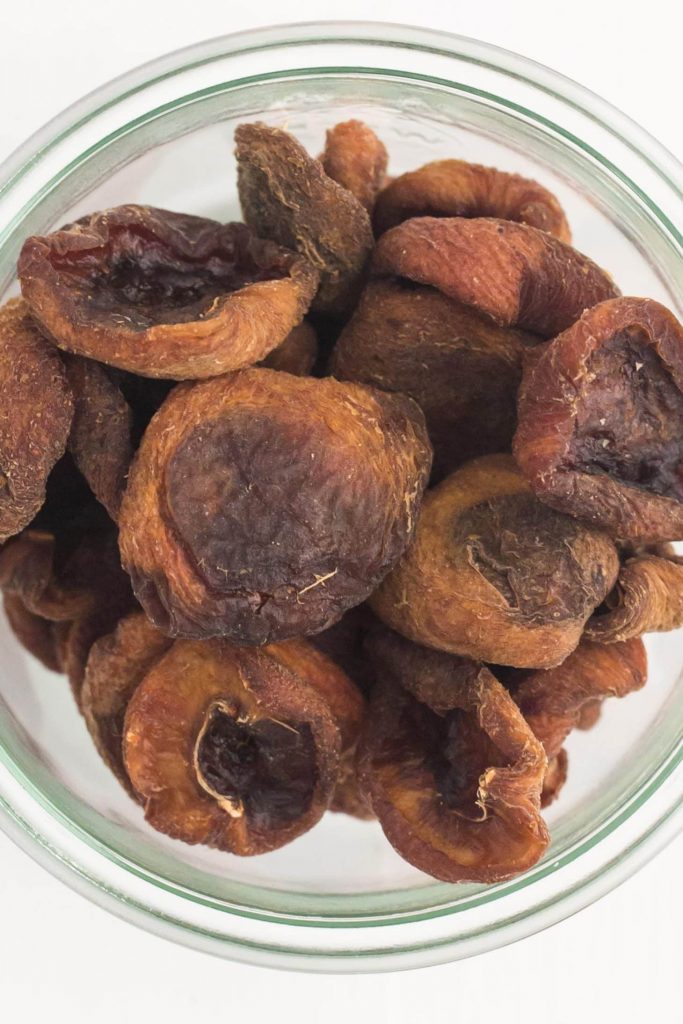Dried Fruits
While I love fresh produce, I also keep a stock of frozen and dried fruits in my house for various uses. All fruits can be dried but I only keep a handful of dried fruits on hand for recipes. One important note: look for dried fruits that contain no added ingredients, like sweeteners or sulfites- they don’t need it. Dried fruits will keep at room temperature storage for up to six months and can be frozen for extended storage- just make sure they are in an airtight container.

Apricots
The fact that I don’t have any recipes using dried apricots on the site is indicative of exactly what I use them for: snacking. At any given time we have a container on hand for mid-day or the occasional late-night snack. I actually prefer apricots in their dried form because their flavor is the perfect balance of sweet and just a little tangy.
Dried apricots can be chopped and added to salads or granola. In a pinch, I’ll use dried apricots in place of golden raisins in curries. I prefer choosing apricots that haven’t been preserved with sulfur, which means they loose their gorgeous orange color and look like the photo to the left. However, the non-sulfured fruits are usually the ones that do not have added sugar.

Cranberries
Somewhere along the line, dried cranberries became one of our salad-topping staples. The little burst of tart sweetness works well in a simple side salad and is perfect with the feta cheese we almost always use. Dried cranberries are also a nice addition to homemade granola, trail mixes, and granola bars. Be sure to look for dried cranberries without added sugar. Many companies will add sugar to cover the tartness but I find the cranberries don’t need it.

Dates
Dates are one of the main reasons I included a dried fruit section in my pantry. I keep Medjool dates on hand as a stand-in sweetener and binder for many recipes. Dates add sweetness to homemade chutneys (featured in the condiment section), are great in homemade granola bars, and are perfect when making homemade larabars. Using dates as a sweetener can be a way to avoid traditional sugars.
There are quite a few different varieties of dates but Medjool and Deglet Noor are the two common varieties sold in most stores. Medjool are soft and sweet, perfect for using in recipes while I like to keep Deglet Noor dates on hand for snacking. Since dates are not fully dried (that’s why they are soft), keep them in an airtight container.

Figs
It wasn’t until moving to California that I fell in love with figs, both fresh and dried. However, fig season is shorter than most other fruits. Dried figs are more practical to eat throughout the year. I primarily keep dried figs on hand as a snack but occasionally use dried figs in granola and granola bar recipes. Similar to apricots, try to select figs that do not contain sulfites.
Any fig can be dried but the most common varieties dried are Mission and Turkish (which are typically grown to be dried). Mission figs are sweet and stay sweet when dried, making them great for baking. Turkish figs are less sweet, which I love for cooking.

Raisins
As a kid, I assumed raisins were always meant for snacking. Lunches and snacks usually had a small box of purple raisins. However, raisins can be a great addition to your cooking pantry. Many curries and some chutney recipes call for golden raisins which add little pockets of sweetness. Raisins can come in many different varieties, not surprisingly because there are many varieties of grapes. Most popular are traditional purple raisins, golden raisins, and currants.
I usually only keep Sultana (golden) raisins on hand for recipes but try different varieties to find the raisins you prefer to snack on and use in recipes.